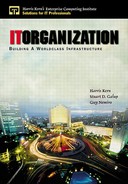Chapter 8. The New Order
In this chapter we discuss how client/server computing is changing the IT department. We discuss the technology and roles that each group now needs to play in this new world.
Client/server technology has changed many relationships within the IT department. The distribution of power is shifting because of the need for team development and deployment of client/server information systems. a team approach that we didn't experience during the mainframe days. How will this redistribution of power change the information technology infrastructure and alter the IT organizational structure? The answers require a rethinking of the distribution of responsibilities.
We started this book by discussing the common problems we found among the 40+ organizations that we studied. We discussed the importance of an infrastructure reminiscent of mainframe days, an infrastructure that is reliable, available, and serviceable. The problem in attaining this RAS environment is the politics that accompany any redistribution of organizational power.
Now let's talk the politics of client/server. Politics you say! Yes, the use of client/server technology has caused IT departments great pains. Internal politics have resulted in the altering of the logical arrangement of IT resources within the department. For example, most IT departments began their foray into the client/server world by creating a separate and distinct applications programming group. They purchased a server, application development tools, and most likely a database engine. Using these tools, they created a local area network and isolated themselves from the network backbone. Ironically, many IT departments treated these groups in the same way that the PC pioneers were treated.
Once the client/server group established its own world within the IT department, it proceeded to establish its own change management process or, in some cases, eliminate the process altogether. The client/server group created the first application and took control and ownership of the installation. In most cases technical support (server administration), network support, and desktop support turned the installation keys over to the client/server group. This left the group with the impression that it could continue down a road separate from the established infrastructure.
This may sound familiar and may have even occurred in your IT department. This set of events unfortunately may just have made the job of integrating the client/server group with the rest of the IT department a difficult and tedious effort.
Autonomous client/server groups that we observed liked being autonomous. They liked having their own rules. They liked not being part of the bureaucratic world of the mainframe-dominated IT department. What is really ironic is that many of the mainframe support groups didn't want the client/server information systems to leave the control and domain of the client/server group. The IT department establishment knew that once the information systems transferred technical support ownership, they were responsible (a responsibility that many of the mainframe staff didn't want).
So, how do we bring the two groups together? How do we bring the disciplines of the mainframe RAS environments to the client/server world? First, we need to decide the demarcation of technologies and the corresponding group that will build or support them. Yes, we know that client/server information systems development often requires desktop, network, database, and development tool knowledge, but this group can't do it all, not if you truly want RAS and an integrated information systems environment.
